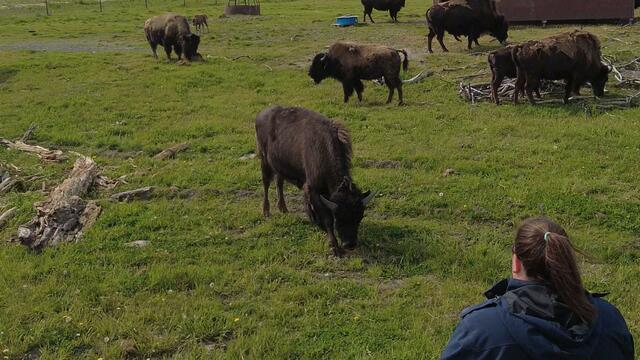▶ Watch Video: Program reintroduces previously-believed extinct wood bison into the U.S.
For centuries, the Athabascan people of Alaska relied on wood bison for survival. That is until the species, deemed by the National Park Service as the largest terrestrial animal in North America, disappeared in the early 1900s.
So when a small herd of wood bison was discovered in a remote section of northern Canada in 1957, a reintroduction program was born to protect the animals from extinction.
“It’s just really cool to be in the presence of a bison,” Sarah Howard, executive director of the Alaska Wildlife Conservation Center, told CBS News correspondent Jeff Glor.
In 2003, the Alaska Wildlife Conservation Center partnered with the Alaska Department of Fish and Game to create a sanctuary where wood bison could successfully breed in captivity.
By 2015, the first herd of 130 bison were transported by plane to Shageluk, Alaska, and successfully released into the wild. A year later, new calves were born.
Biologist Darren Bruning, with the Alaska Department of Fish and Game, said transporting the 2,000-pound animals takes “a lot of patience,” but says their reintroduction into America is “a grand opportunity for restoration of a missing piece of our incredible landscape.”
“I truly can’t believe I get to be part of this,” Bruning told Glor. “It’s a dream come true for me.”
But the conservation project has also had its difficulties.
In 2018, the department reported significant herd losses. The wood bison population that year decreased from an estimated 140 to 91. Biologist Tom Seaton attributed the decline to a “late winter stress event” that “took a toll on the herd.”
“Wood bison are still learning their range,” he wrote at the time. “If luck is with them and the weather is in their favor, they will someday prosper to a larger population and thereby be much more capable to withstand catastrophic snow events.
Despite the harsh winters, conservationists are still committed to reviving the population.
As of the summer of 2021, an all-time high of 26 calves were reported with the herd, growing by more than 10% since 2020. And so far in 2022, five calves have been born.
“Having a bison back out there just creates a healthier environment,” Howard told Glor. “It creates a healthier ecosystem from animals the size of bison all the way down to the voles and the mice.”



































